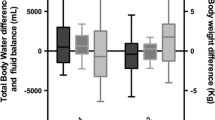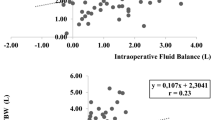Abstract
Objective: To evaluate the relationship between changes in body bioelectrical impedance (BI) at 0.5, 50 and kHz and the changes in body weight, as an index of total body water changes, in acutely ill surgical patients during the rapid infusion of isotonic saline solution.Design: Prospective clinical study.Setting: Multidisciplinary surgical ICU in a university hospital.Patients: Twelve male patients treated for acute surgical illness (multiple trauman=5, major surgeryn=7). Selection criteria: stable cardiovascular parameters, normal cardiac function, signs of hypovolemia (CVP≤5 mmHg, urine ouput <1 ml/kg×h).Interventions: After baseline measurements, a 60 min fluid challenge test was performed with normal saline solution, 0.25 ml/kg.Measurements and results: Body weight (platform digital scale), total body impedance (four-surface electrode technique; measurements at 0.5, 50 and 100 kHz) and urine output. Fluid retention induced a progressive decrease in BI at 0.5, 50 and 100 kHz, but the changes were significant for BI 0.5 and BI 100 only, from 40 min after the beginning of the fluid therapy onwards. There was a significant negative correlation between changes in water retention and BI 0.5, with individual correlation coefficients ranging from −0.72 to 0.95 (p<0.01–0.0001). The slopes of the regression lines indicated that for each kg of water change, there was a mean decrease in BI of 18 ohm, but a substantial inter-individual variability was noted.Conclusion: BI measured at low frequency can represent a valuable index of acute changes in body water in a group of surgical patients but not in a given individual
Similar content being viewed by others
References
Shires T, Williams J, Brown F (1961) Acute change in extracellular fluid associated with major surgical procedures. Ann Surg 154:803–810
Crenshaw CA, Canizaro PC, Shires GT, Allsman A (1962) Changes in extracellular fluid during cute hemorrhagic shock in man. Surg Forum 13:6–7
Randall HT (1976) Fluid, electrolyte, and acid-base balance. Surg Clin North Am 56:1019–1058
Roberts JP, Roberts JD, Skinner C, Shires III GT, Illner H, Canizaro C, Shires GT (1985) Extracellular fluid deficit following operation and its correction with Ringer's lactate. Ann Surg 202:1–8
Böck JC, Barker BC, Clinton AG, Wilson MB, Lewis FR (1989) Posttraumatic changes in, and effect of colloid osmotic pressure on the distribution of body water. Ann Surg 210:395–403
Lowell JA, Schifferdecker C, Driscoll DF, Benotti PN, Bistrian R (1990) Postoperative fluid overload: Not a benign problem. Crit Care Med 18:728–733
Thomasset A (1962) Propriétés bio-électriques des tissus. Mesures de l'impédance en clinique. Signification des courbes obtenues. Lyon Méd 208:107–118
Lukaski HC (1987) Methods for the assessment of human body composition: traditional and new. Am J Clin Nutr 46:537–556
Thomasset A (1963) Propriétés bio-électriques des tissus. Appréciation de la teneur ionique extra-cellulaire et de la teneur ioniquecellulaire en clinique. Lyon Med 209:1325–1352
Nyboer J (1970) Fundamentals of electrical measurement of segmental volume conductors by electrical resistance. In: Thomas CC (ed). Electrical impedance plethismography. The electrical resistive measure of the blood pulse volume, peripheral and central blood flow. Ed 512. Thomas, Springfield, pp 3–49
Hoffer EC, Meador CK, Simpson DC (1969) Correlation of wholebody impedance with total body water volume. J Appl Physiol 27:531–534
Kushner RF, Schoeller A (1986) Estimation of total body water by bioelectrical impedance analysis. Am J Clin Nutr 44:417–424
Vincent JL, De Backer D (1989) Initial management of circulatory shock as prevention of MSOF. Crit Care Clin 5:369–378
Moore FD (1963) The body cell mass and its supporting environment. Body composition in health and disease. Saunders, Philadelphia
Thomasset A, Lenoir J, Roulet C, Ducrot H (1973) Appréciation de la situation électrolytique tissulaire par le rapport des impédances globales du corps humain en basse et haute fréquence. Rev Méd Aéronautique Spatiale 46:312–315
Lukaski HC, Johnson PE, Bolonchuk WW, Lykken G (1985) Assessment of fat-free mass using bioelectrical impedance measurements of the human body. Am J Clin Nutr 41:810–817
Lukaski HC, Bolonchuk WW, Hall CB, Siders W (1986) Validation of tetrapolar bioelectrical impedance method to assess human body composition. J Appl Physiol 60:1327–1332
Segal KR, Loan ML, Fitzgerald PI, Hodgdon JA, Van Itallie T (1988) Lean body mass estimation by bioelectrical impedance analysis: a four-site cross-validation study. Am J Clin Nutr 47:7–14
Pullicino R, Coward WA, Stubbs RJ, Elia M (1990) Bedside and field methods for assessing body composition: comparison with the deuterium dilution technique. Eur J Clin Nutr 44:753–762
Diaz EO, Villar J, Immink M, Gonzales T (1989) Bioimpedance or anthropometry? Eur J Clin Nutr 43:129–137
Tedner BT, Jacobson HS, Linnarsson D, Lins LE (1983) Impedance fluid volume monitoring during intravenous infusion in healthy subjects. Acute Care 84:200–206
Gamble J (1988) The principles governing microvascular transendothelial fluid exchange. Clin Anaesth 2:443–466
Tedner BT (1983) Equipment using an impedance technique for automatic recording of fluid-volume changes during hemodialysis. Med Biol Eng Comput 21:285–290
Tedner B, Lins LE, Asaba H, Wehle B (1985) Evaluation of impedance technique for fluid-volume monitoring during hemodialysis. Int J Clin Monit Comput 2:3–8
Tedner B, Lins LE (1985) Thoughts and progress. Artif Organs 9:416–427
Jebb SA, Elia M (1991) Assessment of changes in total body water in patients undergoing renal dialysis using bioelectrical impedance analysis. Clin Nutr 10:81–84
Schols AMWJ, Wouters EFM, Soeters PB, Westerterp KR (1991) Body composition by bioelectrical-impedance analysis compared with deuterium dilution and skinfold anthropometry in patients with chronic obstructive pulmonary disease. Am J Clin Nutr 53:421–424
Katch FI, Solomon RT, Shayevitz M, Shayewitz B (1986) Validity of bioelectrical impedance to estimate body composition in cardiac and pulmonary patients. Am J Clin Nutr 43:972–973
Raggueneau JL, Gambini D, Levante A, Riche F, De Vernejoul P, Echter E (1979) Monitorage des compartiments hydriques extra-et intra-cellulaires par impédance corporelle. Anesth Anal Réanim 36:439–443
Bolot JF, Bernard G, Laurent G, Robert A, Calemard E, Jenin P, Lenoir J, Thomasset A (1975) Appreciation des mouvements liquidiens sectoriels par mesure de l'impédance globale du corps. Nouv Presse Méd 4:1787–1791
Echter E, Raggueneau JL, Gambini D, Spector M, Riche F, De Vernejoul P (1980) L'impédancemétrie corporelle: méthode non invasive de surveillance des troubles de l'hydratation. Agressologie 21B: 35–41
Ellman H (1984) Capillary permeability in septic patients. Crit Care Med 12:629–633
Schroeder D, Christie PM, Hill GL (1990) Bioelectrical impedance analysis for body composition: clinical evaluation in general surgical patients. JPEN 14:129–133
Baumgartner RN, Chumlea WC, Roche AF (1989) Estimation of body composition from bioelectrical impedance of body segments. Am J Clin Nutr 50:221–226
Author information
Authors and Affiliations
Rights and permissions
About this article
Cite this article
Chioléro, R.L., Gay, L.J., Cotting, J. et al. Assessment of changes in body water by bioimpedance in acutely ill surgical patients. Intensive Care Med 18, 322–326 (1992). https://doi.org/10.1007/BF01694359
Received:
Accepted:
Issue Date:
DOI: https://doi.org/10.1007/BF01694359




